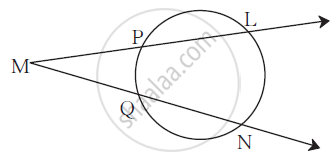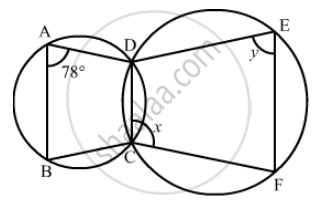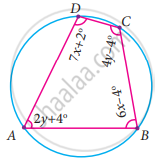Advertisements
Advertisements
प्रश्न
If diagonals of a cyclic quadrilateral are diameters of the circle through the vertices of the quadrilateral, prove that it is a rectangle.
उत्तर

Let ABCD be a cyclic quadrilateral having diagonals BD and AC, intersecting each other at point O.
∠BAD = `1/2angleBOD`
= `180^@/2`
= 90° ...(Consider BD as a chord)
∠BCD + ∠BAD = 180° ...(Cyclic quadrilateral)
∠BCD = 180° − 90° = 90°
∠ADC = `1/2angleAOC`
= `1/2(180^@)`
= 90° ...(Considering AC as a chord)
∠ADC + ∠ABC = 180° ...(Cyclic quadrilateral)
90° + ∠ABC = 180°
∠ABC = 90°
Each interior angle of a cyclic quadrilateral is of 90°. Hence, it is a rectangle.
APPEARS IN
संबंधित प्रश्न
Prove that the circle drawn with any side of a rhombus as diameter passes through the point of intersection of its diagonals.
ABCD is a parallelogram. The circle through A, B and C intersect CD (produced if necessary) at E. Prove that AE = AD.

In the figure m(arc LN) = 110°,
m(arc PQ) = 50° then complete the following activity to find ∠LMN.
∠ LMN = `1/2` [m(arc LN) - _______]
∴ ∠ LMN = `1/2` [_________ - 50°]
∴ ∠ LMN = `1/2` × _________
∴ ∠ LMN = __________
In the given figure, ∠BAD = 78°, ∠DCF = x° and ∠DEF = y°. Find the values of x and y.

ABCD is a cyclic quadrilateral in BC || AD, ∠ADC = 110° and ∠BAC = 50°. Find ∠DAC.
Circles are described on the sides of a triangle as diameters. Prove that the circles on any two sides intersect each other on the third side (or third side produced).
Prove that the perpendicular bisectors of the sides of a cyclic quadrilateral are concurrent.
Find all the angles of the given cyclic quadrilateral ABCD in the figure.
If a line is drawn parallel to the base of an isosceles triangle to intersect its equal sides, prove that the quadrilateral so formed is cyclic.
If P, Q and R are the mid-points of the sides BC, CA and AB of a triangle and AD is the perpendicular from A on BC, prove that P, Q, R and D are concyclic.
